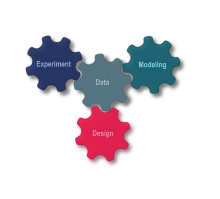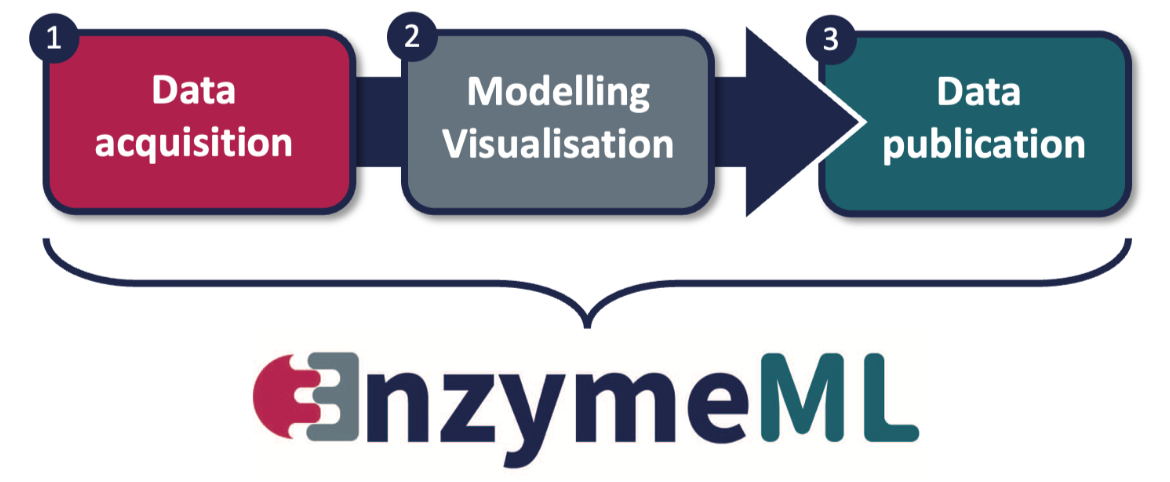Enzymes are proteins that help to build, break down, or convert molecules. In a baking mix, for example, they ensure optimal dough properties, in detergents the removal of stains, and as a glucose sensor they are used to measure blood glucose.
They can speed up chemical processes and assist in the production of food or pharmaceutical ingredients: enzymes. Since they can make many chemical processes more environmentally friendly, they are more in demand than ever, including in research, for example, in order to develop new ways of synthesizing substances. "However, the published research results are often not comprehensive, because information on reaction conditions, such as temperature, is missing," explains Jürgen Pleiss, professor at the Institute of Biochemistry and Technical Biochemistry at the University of Stuttgart. Therefore, he and his team developed EnzymeML as a standardized data exchange format that allows the results of experiments with enzymes to be fully recorded and that also stores the data in a structured manner.
"This makes us pioneers in the field of enzymes, because nothing like this existed yet for biocatalysis, and the data are very complex," says Jürgen Pleiss. There are many databases on enzymes around the world. At present, however, the contents of specialized databases are hardly comparable, as they use different data models and output formats. EnzymeML could be used as a universal, standardized exchange format for specialized databases for the exchange of enzymatic data.
"You can imagine it as a container that has everything I need to repeat the experiment."
Prof. Dr. Jürgen Pleiss
Several studies found that up to 70 percent of the results of experiments in new studies could not be reproduced. Among other things, this so-called replication crisis was the decisive factor for the formulation of the FAIR-Data Principles.
Building on this, the National Research Data Infrastructure (NFDI) initiative was launched in Germany in 2020, which aims to improve the use of data for science and society.
The ML in EnzymeML stands for Markup Language, a machine-readable language that specifies rules for how a text is structured and formatted. This means that the data is standardized and can be read by both computers and humans. The measurement results and metadata are stored in such a way that experiments are repeatable, as all relevant parameters such as the concentrations of enzyme and substrate or temperature, solvent, and pH value are recorded. "You can imagine it as a container that has everything I need to repeat the experiment," explains Jürgen Pleiss.
EnzymeML helps scientists to record data completely. This makes EnzymeML an important step toward the FAIR Data Principles. These are principles that research data must meet in order to be sustainably usable. They must be findable, accessible, interoperable, and reusable. EnzymeML complies with these principles. An integrated interface also enables advanced modeling approaches, as the data can be read out by a modeling software. The simulation of enzyme-catalyzed reactions deepens our understanding of the underlying mechanisms and facilitates the development of novel reaction pathways.
A valuable tool for conducting and analyzing biocatalytic experiments
EnzymeML offers a complete solution for the execution and analysis of biocatalytic experiments: a standardized data exchange format as well as an interface to databases, electronic laboratory journals for data collection, and reliable and accessible data repositories such as DaRUS, the data repository of the University of Stuttgart that is based on Dataverse software. This allows the seamless flow of enzymatic data from measurement to modeling to publication without requiring manual intervention such as reformatting or editing.
The Dataverse project is an open source web application for sharing, archiving, citing, and analyzing research data. It facilitates the provision of data, making it easier to reproduce research.
Data and metadata from the experiment and the modeling process are aggregated into a single file or a EnzymeML Dataverse entry, which can be retrieved via a DOI and serves as a machine-readable micro-publication. The entirety of EnzymeML documents guarantees the reproducibility of enzymatic experiments and enables the re-analysis of enzymatic data. EnzymeML thus contributes to the vision of a unified research data infrastructure for catalysis research. "The data exchange format can also be transferred to other areas, for example, to the measurement of flow in porous media," adds Jürgen Pleiss. "Large amounts of data obtained from experimental procedures under controlled reaction conditions are also a valuable training set for machine learning."
The NFDI4Chem consortium, which is funded by the German Research Foundation (DFG), develops and maintains a data infrastructure for the chemistry research area. EnzymeML is a contribution to a research data infrastructure in the field of enzymology and biocatalysis. In NFDI4Chem, EnzymeML is used as a showcase to demonstrate the benefits of good scientific practice in data management. These concepts can also be applied to the description of non-enzymatic reactions.
Read more:
Pleiss, J. Standardized data, scalable documentation, sustainable storage – EnzymeML as a basis for FAIR data management in biocatalysis. ChemCatChem 13, 3909–3913 (2021). doi: 10.1002/cctc.202100822
Range J, Halupczok C, Lohmann J, Swainston N, Kettner C, Bergmann FT, Weidemann A, Wittig U, Schnell S, Pleiss J, 2022. EnzymeML—a data exchange format for biocatalysis and enzymology. FEBS J 289: 5864-5874. doi: 10.1111/febs.16318
Lauterbach, S., Dienhart, H., Range, J. et al. EnzymeML: seamless data flow and modeling of enzymatic data. Nat Methods 20, 400–402 (2023). doi: 10.1038/s41592-022-01763-1
Pleiss J, 2024. FAIR data and software: improving efficiency and quality of biocatalytic science. ACS Catal 14: 2709−2718. doi: 10.1021/acscatal.3c06337
About the scientist
Jürgen Pleiss studied physics. He received his doctorate from the Max Planck Institute of Biology and the University of Tübingen, then joined Biostructure S.A. in Strasbourg to develop software for protein modeling. After that, he transferred to the University of Stuttgart, where he has been heading the bioinformatics group at the Institute of Biochemistry and Technical Biochemistry since 1995. Today he is professor of bioinformatics. His research activities focus on the design of enzymes by combining bioinformatics and molecular simulation methods, as well as on the application of computer-aided biology in white and red biotechnology. Jürgen Pleiss is also involved in setting up a National Research Data Infrastructure for Chemistry, NFDI4Chem.




